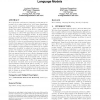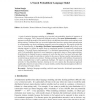770 search results - page 26 / 154 » Subsequence similarity language models |
CIKM
2011
Springer
12 years 8 months ago
2011
Springer
Word prediction performed by language models has an important role in many tasks as e.g. word sense disambiguation, speech recognition, hand-writing recognition, query spelling an...
WER
2007
Springer
14 years 2 months ago
2007
Springer
Since 1996, the core Use Case Map (UCM) notation has remained remarkably stable. As the structure and intent of workflow and scenario languages are very similar, UCMs have been ap...
IJAR
2008
13 years 8 months ago
2008
Credal networks are models that extend Bayesian nets to deal with imprecision in probability, and can actually be regarded as sets of Bayesian nets. Credal nets appear to be power...
NIPS
2000
13 years 9 months ago
2000
A goal of statistical language modeling is to learn the joint probability function of sequences of words in a language. This is intrinsically difficult because of the curse of dim...
EMNLP
2010
13 years 6 months ago
2010
Parser disambiguation with precision grammars generally takes place via statistical ranking of the parse yield of the grammar using a supervised parse selection model. In the stan...


